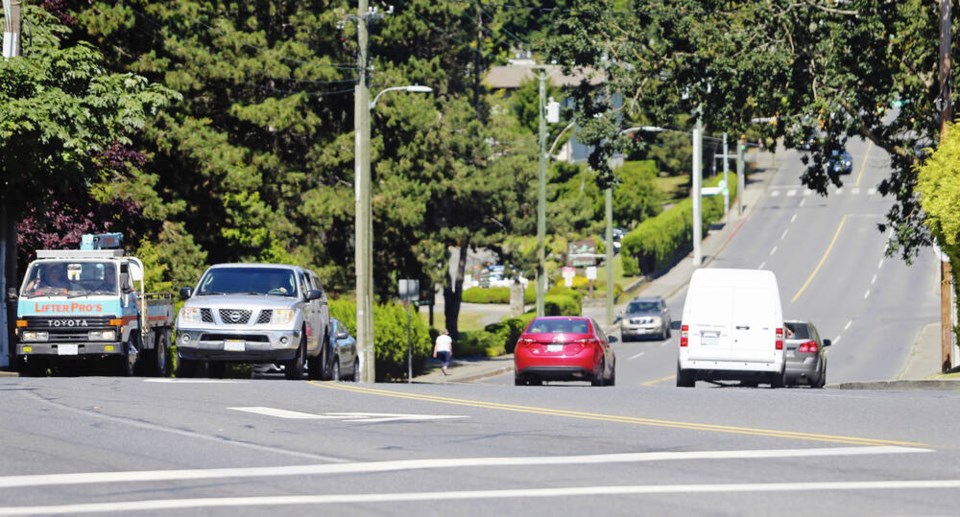Saanich council has given unanimous approval to a plan to evaluate and potentially reduce speed limits on the municipality’s streets.
The default speed limit in B.C. municipalities is 50 kilometres per hour.
A staff report notes that someone hit by a vehicle travelling 56 km/h is five times more likely to die than someone hit by a car travelling 32 km/h.
“Right now they’re at 50 and we’re going to look at some areas going to 40 and 30,” said Saanich Mayor Fred Haynes.
Two types of streets are being considered for speed evaluation, the report says: Type A streets, which don’t have a continuous yellow centre line, and nine Type B corridors, which do.
Type B streets include major thoroughfares and corridors. Among the corridors to be studied are Sayward Road to Cadboro Bay Road, Cedar Hill Cross Road, Harriet Road from Gorge Road West Road to McKenzie Avenue, Tillicum Road, Gorge Road West, Prospect Lake Road, Old West Saanich Road and Oldfield Road, West Saanich Road and Emily Carr Drive.
Haynes said the municipality’s efforts will be “data-driven,” using numbers on crashes, traffic volume and more from sources like police and ICBC. Hearing input from affected residents is another key step, he said.
“There will be neighbourhood experience, road-user experience, what is the cycling volume, what is the walking volume, what is the transit use.”
The road study for the nine Type B corridors is expected to take nine to 11 months and be implemented at the end of 2023, Haynes said. “So we’re going to get at this fairly quickly.”
He said examination of Type A streets is underway, but Type B will come first.
“The issue with Type A is we need all that signage and we don’t have the budget for it right now,” he said. “We’ll be looking at that in 2023.”
About 5,500 new speed-zone signs could be needed for a change on Type A — primarily residential — streets and could cost an estimated $5.6 million. That’s because signs are required on Type A streets for every roadway that comes into them, Haynes said.
Saanich, joined by other municipalities, submitted an application in October 2020 to the Transportation Ministry for a pilot project to reduce speed limits, but staff learned in November 2021 that the ministry had not provided direction for the project to begin, said Coun. Judy Brownoff.
That was followed in January by a letter from the minister’s office encouraging Saanich to use other means to look at speed limits in the district, leading to the current effort.
“I think it would have been beneficial if we could have come together with a pilot and shown the province there is continuity between the municipalities,” Brownoff said.
Haynes said he will be asking for the pilot project to be reconsidered by the province.
He said Saanich councillors have inherited an auto-centric road system from the 1950s and 1960s, but the shift now is more toward active transportation. He said ebikes in particular are making a big difference in how people choose to get around.
Saanich is in contact with neighbouring municipalities Victoria, Oak Bay and Central Saanich about its speed-evaluation plan, Haynes said.
The staff report says momentum is growing among municipalities to manage speed limits as a way to make roads safer for pedestrians, cyclists and drivers.
Vancouver, for example, has launched a “slow zone” project in the Grandview-Woodland area that reduces speeds from 50 km/h to 30 km/h, while Surrey has a project in six residential neighbourhoods that has seen speed limits drop to 30 or 40 km/h, the report said.
In December, a Reynolds Secondary student was killed while crossing Cedar Hill Cross Road in a marked crosswalk, raising concerns about pedestrian safety. In response, the municipality installed several delineators on both sides of the crosswalk at Jennifer Road, along with a new light and warning signs.
>>> To comment on this article, write a letter to the editor: [email protected]



